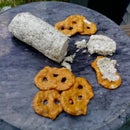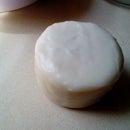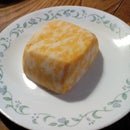Introduction: Design Your Own Fabric
So today I was bored. And not the usual, I'm gonna be on pinterest and drool over crafts I will never make kind of bored. This was the kind of bored that meant I'd A) come up with the oddest way to print fabric, and B) to make an instructable.
Tools you will need:
Fabric of some kind, preferably a solid or tone on tone (I bet you can print on prints though, I just didn't try it)
Acrylic paints. Mine were water based.
Water
Vinegar, the strongest you have.
Card board
White school glue
Scrap fabric for testing
Iron with steam (or non-steaming iron and a iron cloth that has been dampened)
Ironing/pressing cloth
Step 1: Stamp Time!
I drew out a feathery design and a flower. I do not recommend corrugated cardboard for this, but it was all I had so I used it. You can also carve a stamp out of wood, make one from clay, or even an eraser and so on and so forth. Again, I was not really in the mood to spend an hour or so delicately carving out a stamp I was only planning on using once. I used cardboard and glue. Make sure to glue all parts and let thoroughly dry before using (or to a slightly tacky stage.) For wood, I suggest putting a layer of poly over it (or oil and beeswax) to keep it from absorbing your paint.
Anyway, after gluing the parts onto another piece of cardboard or whatever you have lying around that is sturdy (wood block?) begin making a handle for the back. A few layers of cardboard glued together is what I used. Glue to the back and let it all dry for about 20 minutes (long enough for you to get the next step done.)
Step 2: Step 2
Gather your supplies. Fabric, cardboard or something to protect your work surface, and paints in the colors you want. Don't forget some paint brushes, and a palette of some sort to hold the paint. Also, mix in 4 tablespoons of vinegar to 20oz (a water bottle) of water. Shake to combine. Grab your now-dry stamp, and you are ready to get dirty!
Step 3: Step 3- the Fun Begins
Make sure your fabric is not wrinkled (too badly) before you begin. Iron if needed. Paint on the colors on each part of the stamp. Using your scrap fabric, use the stamp a few times to get a feel for it. As you can see, my first tries were less than stellar. If your fabric seems to not be sucking up the paint, add some of the vinegar water a little at a time until it is the right consistency for the fabric to absorb it. You can test the consistency on the fabric by painting some on with your brush. When you get an 'okay' stamp or two, you can start on your 'good' fabric.
Step 4: Stamp a Pattern
As you stamp out the pattern, try changing it up by turning the stamp. I was able to get this rounded block affect with my stamps by alternating 1, 2, 1, 2, and (1), (2), (1), (2). I actually labelled the sides these numbers so I wouldn't get messed up.
Step 5: Iron Your Fabric
After you print your fabric (or fabrics, if you did more than one) place a pressing cloth over the printed side and press on the setting for the fabric you have (I was at the highest because I used cotton.) After you iron the front, flip it over and iron the wrong side of the fabric as well. Make sure to have your iron on steam setting, and put the vinegar water into it. It won't hurt it; vinegar actually helps to clean the iron's steam holes from calcium build up of hard water. And vinegar makes fabric hold on to dye.
If you do not have a steam setting, just dip your pressing cloth into the vinegar water solution and wring out the excess until the cloth is just damp. Iron.
Step 6: Wash It; Scrub a Dub Dub, 2 Prints in the Tub
Run hot water in a tub or sink, and drop in a bar of soap. Add in the prints and vigorously scrub them as though you are trying to get the color off. Don't worry if the bubble turn a very, very light shade of whatever colors you used. If the colors are coming off, you may have skipped a step or not let it dry before ironing. I had such a light, light coloring in the bubbles which really surprised me.
When you have scrubbed the fabric into a bubbly mass, rinse away with warm water. Squeeze out the excess. You can hang or machine dry, but wanted to use mine right away so I ironed them dry.
Step 7: Make Something With Them!
I wanted to show you an example of just one of the many things you can do with your fabric. I meant for this to be a quilted trivet for hot pots, but realized it was the perfect size for my sewing stool (which really, really needed an upgrade.) I added an elastic casing and threaded through some thin elastic.
How did your fabric turn out? And what did you make with it?

Participated in the
Small Spaces Contest

Participated in the
Guerilla Design Contest













